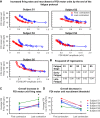Contribution from motor unit firing adaptations and muscle coactivation during fatigue
- PMID: 29537913
- PMCID: PMC6032125
- DOI: 10.1152/jn.00766.2017
Contribution from motor unit firing adaptations and muscle coactivation during fatigue
Abstract
The control of motor unit firing behavior during fatigue is still debated in the literature. Most studies agree that the central nervous system increases the excitation to the motoneuron pool to compensate for decreased force contributions of individual motor units and sustain muscle force output during fatigue. However, some studies claim that motor units may decrease their firing rates despite increased excitation, contradicting the direct relationship between firing rates and excitation that governs the voluntary control of motor units. To investigate whether the control of motor units in fact changes with fatigue, we measured motor unit firing behavior during repeated contractions of the first dorsal interosseous (FDI) muscle while concurrently monitoring the activation of surrounding muscles, including the flexor carpi radialis, extensor carpi radialis, and pronator teres. Across all subjects, we observed an overall increase in FDI activation and motor unit firing rates by the end of the fatigue task. However, in some subjects we observed increases in FDI activation and motor unit firing rates only during the initial phase of the fatigue task, followed by subsequent decreases during the late phase of the fatigue task while the coactivation of surrounding muscles increased. These findings indicate that the strategy for sustaining force output may occasionally change, leading to increases in the relative activation of surrounding muscles while the excitation to the fatiguing muscle decreases. Importantly, irrespective of changes in the strategy for sustaining force output, the control properties regulating motor unit firing behavior remain unchanged during fatigue. NEW & NOTEWORTHY This work addresses sources of debate surrounding the manner in which motor unit firing behavior is controlled during fatigue. We found that decreases in the motor unit firing rates of the fatiguing muscle may occasionally be observed when the contribution of coactive muscles increases. Despite changes in the strategy employed to sustain the force output, the underlying control properties regulating motor unit firing behavior remain unchanged during muscle fatigue.
Keywords: firing rates; force-twitch; motor units; muscle coactivation; muscle fatigue.
Figures





References
-
- Bigland-Ritchie B, Cafarelli E, Vøllestad NK. Fatigue of submaximal static contractions. Acta Physiol Scand Suppl 556: 137–148, 1986a. - PubMed
Publication types
MeSH terms
Grants and funding
LinkOut - more resources
Full Text Sources
Other Literature Sources

